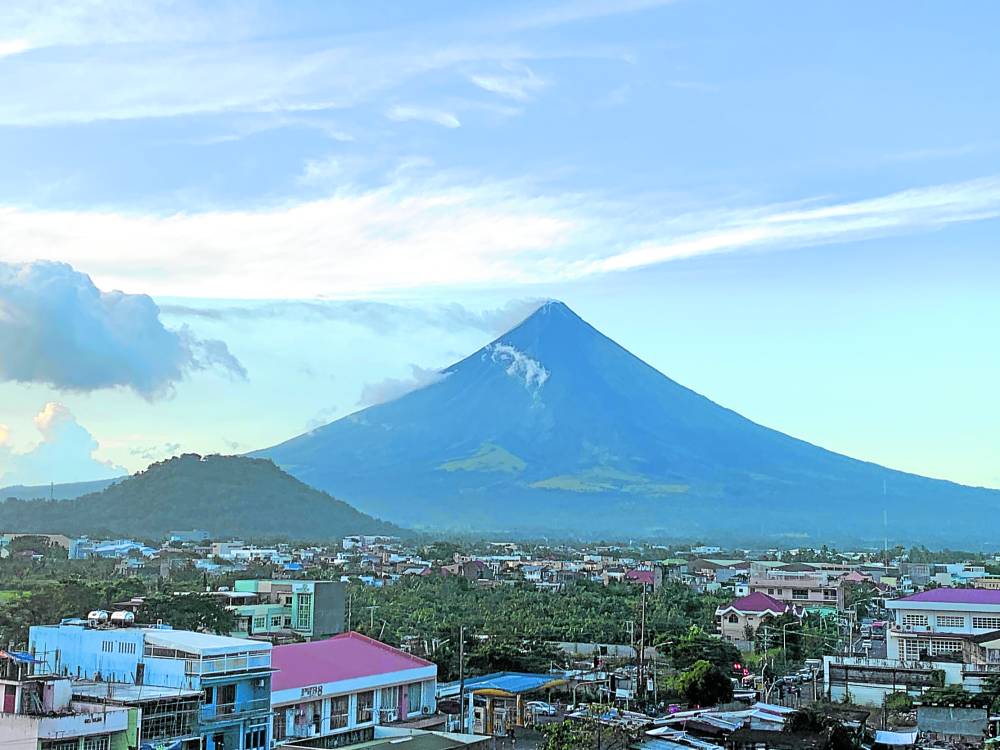Phivolcs alert: Mayon Volcano’s lava dome ‘slowly growing’

RESTLESS Mayon Volcano seems calm in this photo taken in Legazpi City, Albay, on Oct. 8, but the Philippine Institute of Volcanology and Seismology warns on Thursday that its lava dome is growing and hazardous eruption is possible. —JOHN MICHAEL MANJARES/CONTRIBUTOR
LEGAZPI CITY—Residents of towns and cities in Albay province at the foot of Mayon Volcano have to remain on alert as the lava dome at its crater has continued to gradually expand since last month and could lead to a collapse, the Philippine Institute of Volcanology and Seismology (Phivolcs) warned on Wednesday.
In a Facebook post, Phivolcs showed comparative still photos captured by high-resolution camera monitoring of the Mayon Volcano summit, indicating continued very slow growth of its crater lava dome.
Sudden eruptions
If the lava dome continued to slowly grow, it could collapse and possibly generate pyroclastic flow and rock fall along the slopes of the volcano, according to Paul Karson Alanis, resident volcanologist of the Mayon Volcano Observatory Station at Ligñon Hill in this city.
Alanis cautioned residents near the area against being complacent, as sudden eruptions and a lava collapse were still possible.
Phivolcs said approximately 13,500 cubic meters of lava dome have extruded from the crater between Oct. 4 and Nov. 2. This means that from 48,000 cu m in October, it grew to 62,000 cu m in the latest monitoring, said Alanis.
Article continues after this advertisementAlanis said the growth of lava was possibly caused by the hydrothermal activity beneath the edifice.
Article continues after this advertisementModerate emission
He said there was no indication of new magma, and only the remnants of the 2018 eruption were being pushed out.
“If there is a new magma rising, [the lava dome] would grow faster,” Alanis said.
In its Thursday bulletin, Phivolcs did not detect any volcanic earthquake in the past 24 hours of monitoring, while the sulfur dioxide emission was last measured at an average of 260 tonnes per day on Oct. 13.
Phivolcs also observed a “moderate emission” of white steam-laden plumes that crept down slope before drifting to the northeast and west-northwest.
The volcano remained under alert level 2, which was was raised on Oct. 7, due to “increasing unrest” driven by shallow magmatic processes that could eventually lead to phreatic eruptions or hazardous magmatic eruptions.
Danger zone
Entry to Mayon’s 6-kilometer permanent danger zone of the volcano remained strictly prohibited, the Phivolcs said.
The volcano straddles eight localities in Albay province—the cities of Legazpi, Ligao and Tabaco and the towns of Daraga, Camalig, Guinobatan, Malilipot and Santo Domingo.
At the height of the onslaught of Severe Tropical Storm “Paeng” (international name: Nalgae) on Oct. 28, more than 24,000 residents, or 6,052 families, in Albay were evacuated as prolonged rains threatened to trigger volcanic sediment flows, or lahar, along Mayon channels.
Phivolcs has been closely monitoring Mayon since it hoisted alert level 1 (abnormal) over the volcano in August.
Alert level 5, which already indicates “hazardous eruption in progress,” is Phivolcs’ highest warning for a volcano.
RELATED STORY:
Disaster execs prepare evacuation plan as Mount Mayon remains restive